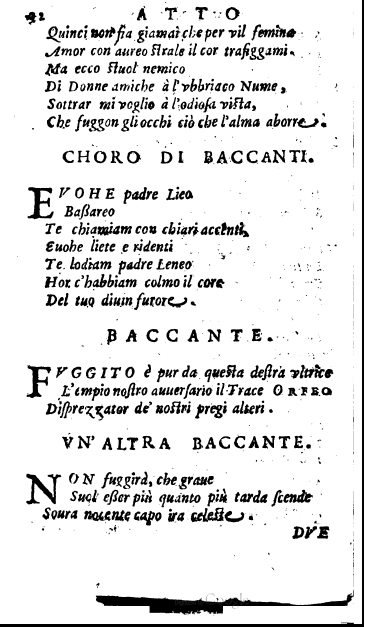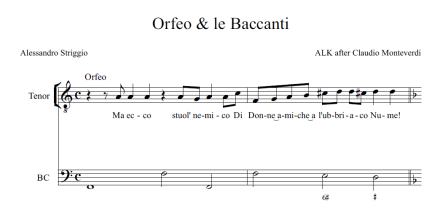This article is posted in connection with the production of Orfeo in Vaasa and Helsinki, October 2019.
With the golden harp I charm mortal ears,
With the powerful harmony of the cosmos I touch your soul.
La Musica, Prologue to L’Orfeo
More about the Philosophy of La Musica here…
The Theatre of Dreams: La Musica hypnotises the Heroes here…
Monteverdi’s music is Rhetoric that tells a story, delights the senses and stirs your emotions. Although it is one of the earliest music-dramas to be presented in today’s Opera Houses, L’Orfeo was not the ‘first opera’. The designation in Striggio’s (1607) libretto here… as favella in musica… (a story in music) …rappresentata ( a theatrical show) in Mantua, associates this music-drama with Cavalieri’s (1600) Rappresentatione di Anima e di Corpo in Rome, and with Peri and Caccini’s Euridice, performed in Florence later that same year.
Monteverdi’s Score was printed in 1609 here…, not to facilitate future performances, but as a souvenir of the original production, with many details of instrumentation and staging not often found in early baroque sources. There were three groups of instruments distributed around the stage: strings and flutes, cornetti and sackbuts, and the Basso Continuo who ‘supported and guided the whole ensemble of voices and instruments’ (Agazzari, 1607). There was no conductor: rhythmic precision was based on the steady pulse of Baroque Tactus more about Monteverdi’s rhythm here…; rehearsals were led by the Corago (opera director) more about Il Corago here…
For this new genre of music-drama, the performers were not theatre actors but court singers, with star tenor Francesco Rasi in the title-role. And the first performance was not in a purpose-built theatre, but in a small hall inside the Ducal Palace, without the grandiose stage-machinery used in the 1589 Florentine Intermedi. Nevertheless, the show was a great success, and the following year the spirit of this music led to the birth of the Tragedy, Arianna, Monteverdi’s lost masterpiece (reconstructed by Lawrence-King in 2017 from the surviving Lamento). More about Arianna a la Recherche here…
Libretto and Score offer alternative endings, in which Orpheus either encounters a gang of Bacchus’ followers, or is rescued by Apollo. In the 2019 staging in Finland, you must wait and see who triumphs in the end: Apollo (Monteverdi’s original setting) or Bacchus (in Lawrence-King’s reconstruction for this production)?
Whilst we might today view L ‘Orfeo as a symbolic journey, 17th-century audiences appreciated it as an allegory of music-drama’s power ‘move the passions’. They experienced the emotional impact of hearing the story narrated by La Musica and the Messaggiera, watching the same story dramatised by actors on stage, whilst both seeing and hearing how Orpheus himself reacts to each new event. As courtiers, the Mantuan spectators were accustomed to watching their Duke, in order to gauge his reaction to any happening. On stage, Orpheus’ Shepherds represent a pastoral ‘court’ surrounding the semi-divine singer.
A stage court, a dramatised wedding more about the Ballo for Orpheus’ wedding here…, and a mythical singer as protagonist all serve to make music ‘realistic’ within this story. The Muses themselves appear from Parnassus, and baroque audiences were thrilled by the horrors of Hell. Striggio’s inferno is deliberately modelled on Dante. Ordinary speech is represented not by the Recitative more about Recitative here… that we know from Handel and Vivaldi, but by earlier modulatione, Monody, in which Monteverdi’s precisely notated rhythms and pitch-contours imitate the rhetorical delivery of a fine actor in the spoken theatre (Peri, 1600, Il Corago c1630). More about Peri’s monody here…
Tim Carter’s survey of Monteverdi’s Musical Theatre here…
Caccini defines this ‘new music’ (1601) as “words and rhythm, with sound last of all, and not the other way around”. More about Caccini here… Monteverdi, Caccini and Jazz here… Cavalieri (1600) alerts us to abrupt contrasts in emotion. More about Cavalieri here… Monteverdi declares (1638) that his purpose was to bring narration, action and music together into ‘a unified representation’. In this Gesamtkunstwerk, centuries before Nietzsche and Wagner, Apollo and Bacchus contend to charm your ears and touch your soul.
The Orfeo page by Il Corago here…







Pingback: Understand, enjoy and be moved! Listening to the Rhetoric of Orfeo | Andrew Lawrence-King
Pingback: The Minister’s Conditions in Monteverdi’s Orfeo | Andrew Lawrence-King